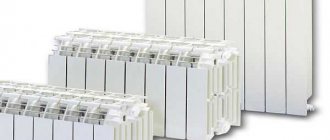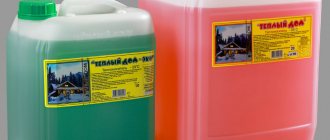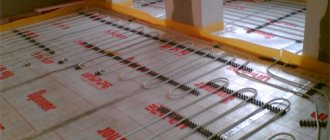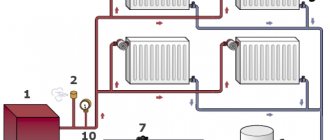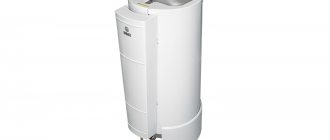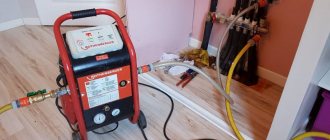The main danger for heating a private home is the possibility of freezing of the heating system. In order to prevent such moments, antifreeze is used. There are many brands of antifreeze for home heating; their composition is similar to antifreeze for cars.
Based on this, many people have a question: can car antifreeze be used at home? Will this lead to irreparable consequences for the heating system and how profitable will it be from a financial point of view? Let's take a closer look at the properties of antifreeze and answer all the questions that arise.
Usually the heating system is filled with water, but if the pipe or battery freezes, it may burst, and when using antifreeze as a filler for the heating system, you should not be afraid of this, since even with a significant drop in temperature, the antifreeze does not crystallize, but becomes a jelly-like consistency.
Is it possible to use car antifreeze in a heating system?
Only specially developed antifreeze is allowed to be used in heating systems. Most antifreezes contain nitrites, amines, phosphate and silicate compounds, which form fumes harmful to humans. In addition, they do not contain the additives necessary for use in heating systems and can have a bad effect on metals and rubber seals. Antifreezes have a limited service life (2-3 years) and are not designed for dilution at all, especially with tap water.
Ethylene glycol products
Ethylene glycol has a slightly oily texture, comes in several colors, and is odorless. The disadvantage of this type of antifreeze is its high toxicity. Avoid direct inhalation or contact with unprotected skin. This can lead to serious consequences, including death.
For this reason, its use for a heating system is limited - it cannot be used if there is a risk that the coolant may get into the hot water supply pipeline.
A red dye is added to antifreeze to alert people to the properties of the product and allow them to instantly see the leak. Such antifreezes are used up to temperatures of minus 65 degrees. It is noteworthy that ethylene glycol-based antifreezes are prohibited for use in some countries.
What water is best to dilute antifreeze?
Ideally, it is better to dilute with distilled water, which does not contain calcium and magnesium salts. The fact is that when antifreeze is diluted with hard water, sediment may form. Can also be diluted with tap water, but with a hardness of up to 5 mEq/l.
For information: water from a well, if a softening system is not provided, can have a hardness of 20 mEq/l. If it is difficult to determine the hardness, it is recommended to first mix the antifreeze with water in the required proportion in a transparent container and make sure there is no sediment.
Other components
Recipes for factory-made antifreeze liquids necessarily contain surfactants. They are designed to remove dirt, soot, grime, oil and anything else that may limit visibility from the glass surface.
For a liquid to be effective in cleaning glass, very few surfactants are required. Flavorings are also used in the production process. They serve to give the product a pleasant smell. Manufacturers often use the scent of apples, citrus fruits or any other product with a persistent and “tasty” aroma. Dyes color liquids in different colors. This makes it easier for the buyer to identify the desired product. Separately, it is necessary to say about water. For the manufacture of the highest class products, distilled is best suited. In some cases, it is possible to use artesian water with a minimum of salts. But the most ordinary one (from the tap) is not suitable for making anti-freeze.
How does antifreeze affect heating system radiators and the boiler?
Since the heat capacity of antifreeze is approximately 15–20% lower than that of water, and it accumulates and releases heat worse, the radiators of the heating system should be chosen more powerful than when using water. It is best to choose a radiator with 20% more heat transfer.
Just like with radiators, heat removal drops at the boiler heat exchanger. Therefore, it is necessary to install a more powerful circulation pump than when working on water. Even in the case of a reasonable glycol content in the solution, designed for -20°C or -25°C, you need to choose a pump with a flow rate of 10% more and a pressure of 60%.
If antifreeze is used with a wall-mounted boiler in which the pump is already installed inside, everything must be done to improve circulation through the boiler heat exchanger, namely, increase the diameter of all pipes in the heating system, and select radiators with less resistance. If the boiler is already installed, and there is no possibility to change anything in the heating system, you can reduce the power of the boiler when working on the heating circuit by 20% (if possible).
You can also install a more powerful pump instead of the standard one. For wall-mounted heating boilers, such pumps are usually offered as additional options.
How antifreeze works
As we all know from the school curriculum, water freezes at zero degrees and takes the form of ice. In this case, expansion occurs, and the vessels (in our case, pipes) may simply not be able to withstand it. If such a situation arises, it is necessary to change the elements of the heating system (pipes or radiators).
However, if you use antifreeze, this can be avoided. It mixes very well with water and even at a very small concentration the freezing point becomes different. Expansion will undoubtedly occur, but not sharply, and it will not cause any damage.
What will be the consequences of using undiluted antifreeze in a heating system at -65°C?
The boiler heat exchanger will begin to overheat due to insufficient heat removal. With prolonged overheating, thermal decomposition of additives and the glycol itself begins. The coolant becomes dark brown and precipitation forms. The copper heat exchanger of the wall-mounted boiler begins to make noise and vibrate due to local boiling of the coolant. The worst thing is that dark carbon deposits form inside the heat exchanger, which causes even greater overheating. As a result, the heat exchanger will need to be replaced.
How to choose the right heating fluid
It is difficult to imagine comfortable living in an apartment or private house in winter without high-quality heating. Residents of urban high-rise buildings with centralized heating are lucky. After all, there is no need to think or worry about the safety of pipes during the cold period. Maintenance falls on the shoulders of housing maintenance offices. But you have to monitor the proper operation of the autonomous heating system in the private sector yourself.
A coolant is used as a heating element in the heating network. It is a heating fluid that circulates through the circuit. May be of different types. The operation and maintenance of the system depends on what kind of liquid is used. Therefore, this article will focus on the coolant, its types and rules of use.
Why do you have to recharge a system filled with antifreeze, and how to do it correctly?
Antifreeze is a more fluid liquid than water, hence the increased requirements for detachable connections of the heating system. Therefore, it is necessary to more carefully assemble all docking units and be sure to carry out preliminary pressure testing of the system. If necessary, joints in systems can be treated with sealants resistant to glycol mixtures (Germesil, ABRO, LOCTITE).
As for recharging a heating system running on antifreeze, it cannot be recharged with tap water for several reasons: salt precipitation is possible, and the more diluted the antifreeze, the fewer additives it contains, and the glycol mixture becomes aggressive. Some antifreeze manufacturers recommend adding additives separately, the so-called “master concentrate,” when diluting with water by more than 50%. It is also necessary to remember that when diluted to a temperature above -15°C, many non-freezing coolants begin to lose their properties. It is recommended to keep a container with the prepared glycol mixture in the boiler room and feed the system only from it.
These are all the answers to 10 questions about the practical use of antifreeze in heating systems.
©Obotoplenii.ru
Other articles on the topic: Heating installation
- Heating system pumps: types and methods of installation of heating circulation pumps
- Home heating: where to choose home heating
- Flushing the heating system: methods for flushing heating
- Marking of circulation pumps for heating systems
- Methods for laying heating pipes
- Heating system with solid fuel boiler for houses over 25 kW
- Methods of heating a private house: choosing how to heat the house
In what systems can antifreeze liquid be used?
There are a number of restrictions on the use of antifreeze:
- Antifreeze liquid, regardless of its chemical composition, can only be used in a closed circuit. This means that there is constant pressure in the system, circulation is constantly forced, due to the pump.
- Coolants are not used with electrolysis-type electric boilers. Electrolysis type is when the coolant is used as an electrical conductor. The electrical conductivity of coolants is low, and this will lead to high energy costs.
- Antifreeze liquids must not be used in contact with galvanized surfaces (pipes).
Heating a country house: types. Use of furnaces, water, gas and electrical systems
If you are planning to equip your dacha not only as a place for a seasonal stay, but also for living in the winter, one fireplace as a heating source is not enough. But how to choose heating for a country house so that it is as efficient as possible and at the same time affordable? Next, we will try to answer this question and consider possible options for heating a country house.
For year-round living in a country house, a high-quality heating system is necessary.
Types of heating
All existing types of heating primarily differ in the type of energy carrier on which they can operate.
The most common options for heating a country house are:
- On gas;
- Electricity;
- Solid fuel;
- Liquid fuel.
In addition, there are several types of heating methods for a country house:
Air heating circuit
In many ways, the choice of heating type depends on the following factors:
| Fuel availability | Does the village have gas or electricity, is it possible to stock up on firewood or other solid fuel, etc. |
| Proximity to communications | Communications include primarily power lines and gas pipelines |
| Building characteristics | The area that needs to be heated, the level of heat loss, etc. |
When deciding how to heat a country house in winter, you should familiarize yourself with the features of each system.
In particular, it is necessary to pay attention to such aspects as:
- The price of the fuel on which the system operates;
- Cost of system elements;
- Installation cost or option to install yourself.
Next, we will take a closer look at the features of different types of heating.
Bake
Bake
Heating a country house using solid fuel using a stove is a fairly common option. If the dacha is used in late autumn and early spring, then it can be heated with a stove.
However, such heating cannot be called ideal, as it has quite a few disadvantages:
- The oven takes up a lot of space;
- It is necessary to ensure a supply of fuel;
- It is very difficult to install a stove with your own hands; moreover, this procedure requires serious reconstruction of the house.
- The house warms up unevenly; remote rooms are much colder than those close to the stove.
Boiler for water heating using solid fuel
Water heating
Perhaps water heating for a country house is the most common. Its principle is based on the fact that a heat source heats a liquid, which distributes heat throughout the system.
Most often, water is used as a coolant, however, in some cases, a country house is heated with antifreeze. The main advantage of water heating is the ability to maintain optimal temperature in the premises.
The simplest water heating scheme consists of the following elements:
- Fuel boiler;
- Heat transfer batteries;
- Expansion tank.
Another advantage of such a system is the ability to heat the house with any energy source, for example, wood or gas. The power of the heat supply source is selected in accordance with the area of the house.
Water circulation in the system can be carried out in two ways:
- Natural - circulation is carried out due to the difference in density of cold and heated liquid. Water or antifreeze is heated in the boiler, after which it moves through pipes to the heating radiators. Here the coolant is cooled and returned to the heat source via return lines.
This process is continuous. To achieve optimal water pressure, the boiler is located below floor level. This system is an excellent option for heating small buildings.
- Forced - the system uses a circulation pump, which ensures constant movement of liquid in the pipes, as well as uniform heating of all rooms. The disadvantage of such a system is that its uninterrupted operation depends on the availability of electricity.
Advice! If there is no power supply on the site, then renting a diesel generator for the dacha will help solve the problem.
Heating scheme with forced water circulation
It must be said that in a water heating system it is possible to supply hot water not only for heating, but also for domestic needs. For this purpose, double-circuit boilers are used, the design of which provides for the possibility of heating water for both purposes.
In addition, it is possible to heat a country house with your own hands, such as a “warm floor”, which can serve as a complement to traditional radiators or even as an alternative to batteries. In contrast, heated floors warm the room better and do not dry out the air.
Summarizing all of the above, we can highlight the following advantages of water heating:
- Low cost of equipment;
- Possibility of choosing energy carrier;
- High heat capacity of the carrier.
Along with the advantages, there are also some disadvantages:
- Difficulty in installing the system;
- Constant monitoring of equipment operation is required;
- System elements are susceptible to corrosion;
- The boiler takes up some space, although it is smaller than the oven.
A gas boiler
Gas heating
Separately, it should be said about gas heating, which also applies to water heating. It is perhaps the most convenient to use and effective.
Gas heating in a country house, made using modern heating equipment, can provide the house with warmth and comfort even in the most inclement weather.
The only disadvantage of this option is the need to connect to a central highway, which is not available everywhere. True, regular purchase of gas cylinders can be considered as an option.
Among the main advantages of such a system are the following:
- Affordable gas prices;
- Easy installation of the system;
- Ease of operation of the equipment.
- High heating efficiency;
- Environmentally friendly.
Convectors
Electric heating
Thanks to the direct transformation of electricity into thermal energy, electric heating systems for a country house do not require the installation of a coolant. You just need to install heating elements.
This heating technology is very popular in Europe. In our country, it is used less frequently, which is due to frequent power outages in rural areas, as well as the relatively high cost of electricity.
However, if there is no gas supply in a holiday village and there are difficulties in procuring solid fuel, then when deciding how to heat a country house, you can give preference to electric heating.
Currently there are four groups of such heating:
- Floor heating system;
- Convectors;
- Infrared heaters;
- Combinable devices.
In the photo - infrared heater
Among the advantages of electric heating, the following points can be highlighted:
- There is no need for special maintenance;
- Easy installation;
- The systems do not take up useful space in the room;
- Quiet and environmentally friendly.
As for the disadvantages, they include:
- Quite high costs of heating a house;
- Possible power outages;
- Wiring may need to be replaced prior to installation.
Advice! If you have purchased a summer cottage without buildings and do not know how best to equip it, you can pay attention to country houses made from block containers, which are quickly erected and have good thermal insulation properties.
Here, perhaps, are all the main heating methods that can be used in a country house.
Conclusion
There are quite a few options for organizing the heating of a country house with your own hands. Therefore, the choice should be based on the specific conditions in each individual case. This will allow you to organize heating most efficiently.
You can get more information on this topic from the video in this article.
Add to favorites Printable version
9dach.ru
Starting the heating of an apartment building
In a multi-storey building with bottom filling, the heating system is started as follows:
- When the supply is closed and the return is closed, the discharge of the supply pipeline opens;
- The return valve opens very smoothly. A sudden opening of the valve will most likely lead to water hammer, which can seriously damage the radiators, even to the point of rupture;
- After some time, water without air will come out of the discharge. When this happens, the discharge closes and the supply pipeline valve opens;
- All that remains is to bleed the air from all parts of the system where this is possible.
Preparing the solution and pouring it
Washing and filling pipes with antifreeze
In order to add antifreeze to the home heating system, you need to choose the right composition. All manufacturers produce ready-to-fill liquids. The temperature at which crystallization occurs is indicated in the name. For example - A40-M (-40°C). It is important to know that ready-made antifreeze cannot be diluted with water. To do this, you need to use special concentrates consisting of 95% ethylene glycol.
Preparing antifreeze solution for heating
To properly fill antifreeze into the heating system, it is best to use concentrate. This provides additional benefits, since you can independently choose the ratio of antifreeze to distilled water. In addition, it is more common to find counterfeits of a ready-made solution than of a concentrate.
First you need to determine the minimum temperature at which the effect of crystallization of the coolant will not be observed. To do this, you need to know the ratio of antifreeze for heating a house to water. They are presented in the table.
| Concentrate to water ratio | Freezing temperature, °C |
| 1:1 | -40 |
| 2:3 | -30 |
| 1:2 | -20 |
But first you need to check whether this antifreeze can be poured into the heating system. To do this, make a solution in a small transparent container (glass) and leave it for several days at room temperature. After this period, no sediment or foam formation should be observed in the liquid. If this is present, the quality of the concentrate is very low.
If there is a leak of antifreeze from the heating system, you must first ventilate the room, eliminate the accident and thoroughly wash the places where it got in.
Pouring antifreeze into the heating system
To fill, it is best to cut off the top of the container.
Having decided that this particular brand of antifreeze can be poured into the heating, we begin to prepare the system. First, all the coolant is drained. If antifreeze was previously poured into the pipeline, under no circumstances should it be mixed with the new solution.
Then the following actions are performed:
- Thorough cleaning of pipes and radiators. Before adding antifreeze solution to the home heating system, you need to remove all internal contaminants. It is best to perform several circuses until the water is completely clear;
- Checking all connections and pipe joints. It is imperative to replace the rubber gaskets;
- Pressure testing is necessary to check the system for a possible increase in normal pressure. In this way, it is possible to identify elements with hidden defects;
- Filling antifreeze for the heating system using a special pump.
All safety rules must be followed during this procedure. The room must be well ventilated - all windows and doors open. A protective suit, respirator and rubber gloves must be used. If, when pouring antifreeze into the heating system, it gets on an open area of skin, you should immediately rinse it with water. If a chemical burn occurs, consult a doctor.
The lower the concentration of antifreeze, the lower the likelihood of getting a chemical burn.
Other ways to heat a dacha without electricity
There are other methods of autonomous heating. First of all, these are traditional brick stoves and potbelly stoves. And if the former also require the participation of a designer and a master stove-maker, then installing the latter is not difficult. The main thing is to remove the chimney and protect it from contact with the ceilings with non-combustible material.
Another relatively inexpensive and easily installed heating method for a summer house is a diesel stove. The operating principle is to burn liquid fuel. The cost of such fuel is usually not high, and there are no special requirements for its storage. You just need to prevent fuel oil from spilling, as this will harm the surrounding environment. Diesel fuel stoves can be made independently. Having a simple design, they are able to quickly heat a small room and are therefore a suitable option for a summer residence.
How to do this correctly?
First, you should remove the old antifreeze from the tank - it is located in the radiator and also in the cylinder block. When carrying out work, the car should be placed on a hill - this way much more of the cooling mixture will drain out. The system should be flushed with distilled water; It’s also worth adding special. means for carrying out work.
Antifreeze should not be poured into the car to the brim, the lid should be open, then the car engine is turned on again and the air is released into the space. Afterwards the neck should be screwed on. Prepare and place a container under the cooling drain points in advance. mixtures in cars. Next, you should unscrew the drain valve on the cooling system. You need to open it as carefully as possible, and do this while pouring antifreeze. Perform the draining itself slowly. After you have drained the main part of the coolant
mixture, unscrew the lid. It is also worth paying attention to the fact that the pipe systems and tap can be located at different points, since much depends on the design solutions of the car. After draining the car's coolant, you should seal the cooling system by turning off the pipes and the valve. After that you can start filling in a new portion of antifreeze. To prevent the mixture from spilling, it is worth placing the watering can in a special expansion tank or insert it into the radiator
It is usually located under the hood; Next, take a container and fill it with antifreeze. This should be done gradually, while trying not to pour all of your antifreeze into the tank in one fell swoop. It is worth remembering that if the pressure is too high, a water plug may appear. It is also worth noting that the extension. The tank usually has a maximum fill mark and a minimum fill mark. That is why it is recommended to pour no more cooling mixture than the set level. When pouring antifreeze or antifreeze, it is worth screwing the cap of the expansion tank tighter.
This is essentially almost all actions. Now you understand how to properly fill in antifreeze (you can understand in more detail in the video below). After all these procedures, it is better to play it safe and start your car, allowing it to reach the required temperature.
Also check how the car's cooling system works and what condition it is in. Check the antifreeze level in it.
Every car needs coolant
The most important thing is to be able to choose it correctly. Therefore, sooner or later all new drivers are interested in whether it is possible to mix antifreeze with antifreeze? Coolant is a chemical substance necessary for gasoline and diesel engines.
The liquid is characterized by high boiling and freezing rates in the engine cooling system. Due to this, it is possible to use the machine at any ambient temperature. The coolant not only protects the engine from overheating, but also warms it up much faster at low temperatures. Antifreeze was formulated by foreign manufacturers using carboxylate technology. In addition to distilled water and ethylene glycol, it contains additives based on salts of organic acids. According to the classification, imported coolants (coolants) most often belong to organic compounds.
Cooling system diagram
The consistency of the coolant is different, which divides it into types:
- Reds.
- Green.
- Blue.
- Yellow.
In principle, they are similar, the only differences are in composition and temperature conditions. There is an erroneous statement that color affects the chemical characteristics of the coolant. In fact, this is done to make it easier to diagnose the node. It is impossible to single out which color is better, since the main thing is not the color, but the chemical and physical properties of the antifreeze.
